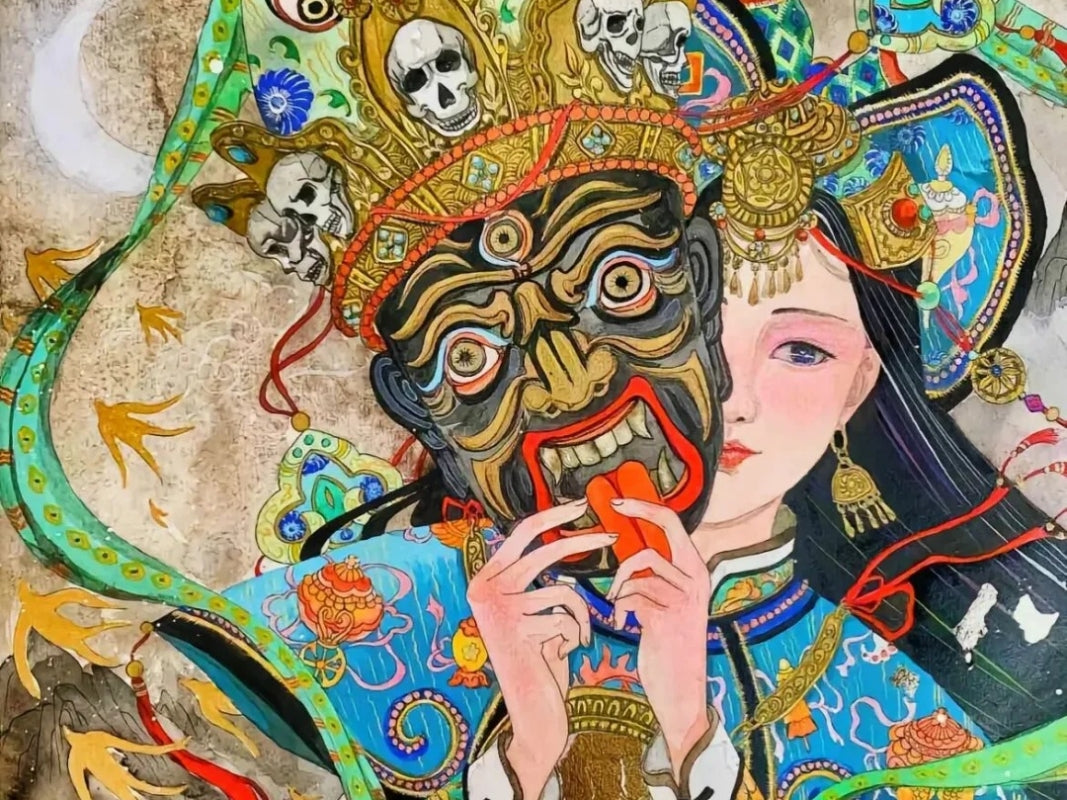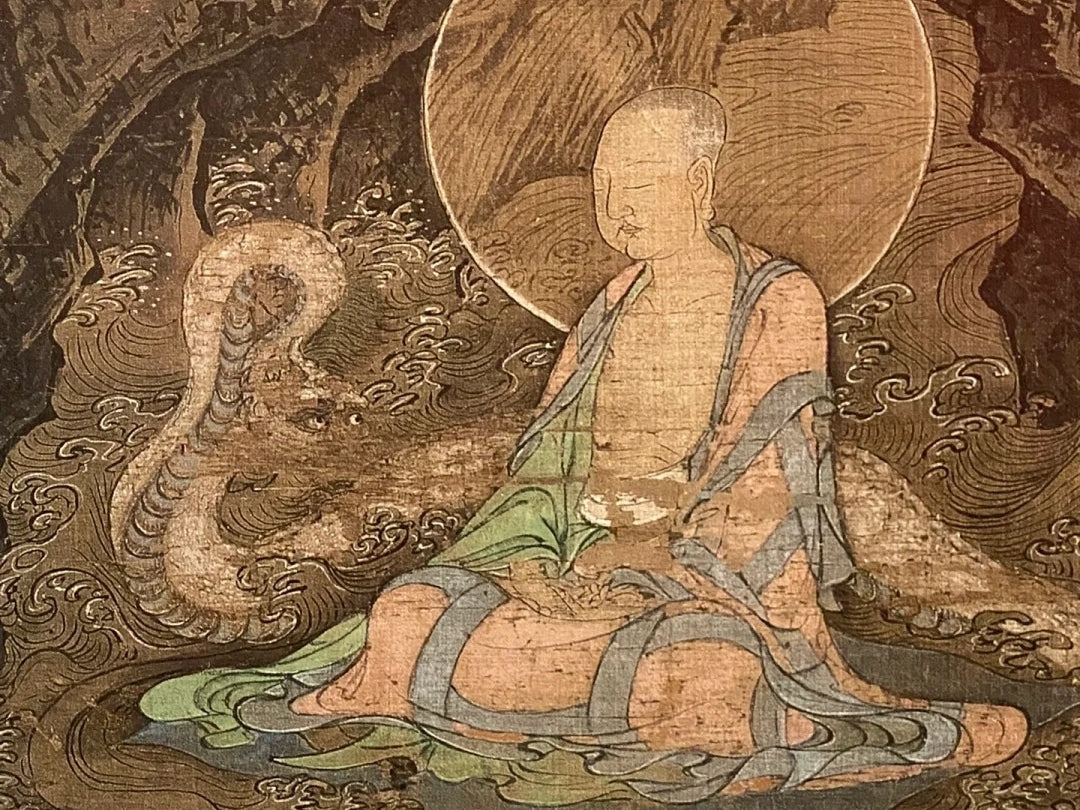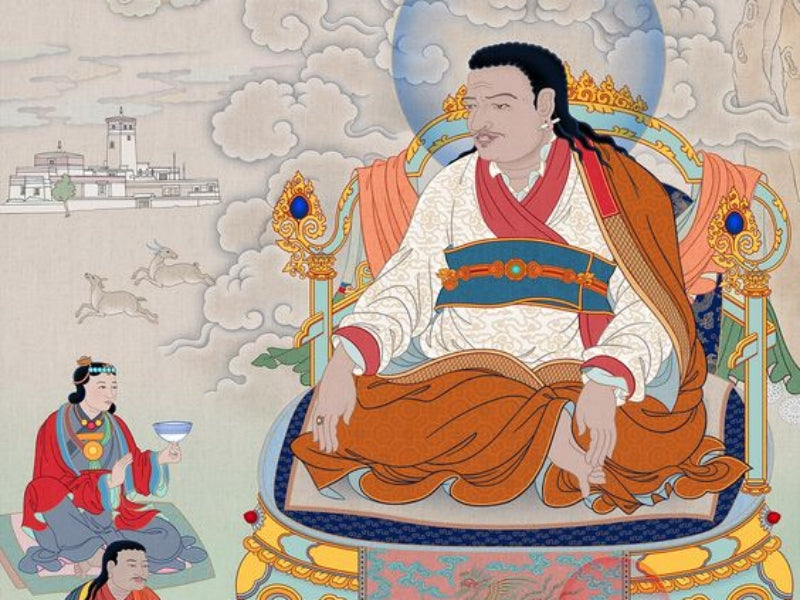Zakiram: The Mystical Goddess Behind Tibetan Buddhist Jewelry
Zha Ji La Mu (Zakiram扎基拉姆) is a significant goddess in Tibetan Buddhism, revered as a worldly protector deity. Unlike transcendental protector deities like Palden Lhamo, Zha Ji La Mu(Zakiram) is believed to still have earthly ties and is renowned for her association with fortune and protection. Widely considered an embodiment of the goddess Palden Lhamo, she is a symbol of auspiciousness and protection. Her stories have been passed down through generations, becoming a source of mystery and sacredness for believers. Her image frequently appears in Tibetan Buddhist art, such as thangka paintings, thangka Buddha pendant, murals, and sculptures. The name "Zha Ji" comes from Sanskrit, meaning "auspicious."


The Origins and Legacy of Zha Ji La Mu(Zakiram)
The origins of Zha Ji La Mu(Zakiram) trace back to ancient times. According to legend, she saved many lives and spread Buddhist teachings to numerous followers. As a result, she is seen as a symbol of wealth and happiness. Tibetan Buddhists hold Zha Ji La Mu(Zakiram) in high regard, as she is both a compassionate Bodhisattva and a powerful protector deity. It is believed that she can ward off evil, protect people from harm, and ensure peace.
The Myth of the Tibetan Goddess of Wealth
According to legend, Zha Ji La Mu was once a consort of Emperor Qianlong (乾隆, 1711–1799) during the Qing Dynasty. Her beauty attracted jealousy from other women, leading to her untimely death through treachery. After her passing, her spirit lingered, seeking revenge on those who wronged her. Her unrest was brought to the attention of Emperor Qianlong, who sought help from a renowned Tibetan Buddhist monk, Chizhang Tsang (切扎仓), who was on a pilgrimage to Mount Wutai (五台山).
The monk, after hearing her story, convinced Emperor Qianlong to punish those responsible for her death. He then performed Buddhist rituals to ease her spirit and guide her to rebirth in the Pure Land. However, on his journey back to Sera Monastery (色拉寺), the monk found her spirit still following him. She expressed her desire to renounce worldly attachments and follow the monk as a Buddhist devotee. Despite initial resistance, the monk was moved by her sincerity and allowed her to follow him.
Before reaching the monastery, the monk explained that she could not enter but offered to build a small temple for her to be worshipped by the people. Zha Ji La Mu agreed and became a guardian deity who dedicated herself to helping those who came to seek her blessings. Over time, her temple became a place of strong spiritual activity, attracting more and more followers.

Zha Ji Temple: Tibet’s Only Temple of Wealth
Located on Zha Ji Road in the northern suburbs of Lhasa, Zha Ji Temple (扎基寺) is Tibet’s only temple dedicated to the goddess of wealth. Despite its small size, the temple is always filled with incense and prayers from devotees. Zha Ji Temple is a branch of the Sera Monastery, part of the Gelug school of Tibetan Buddhism, and is open to the public for free. In Tibetan, "Zhaba" means monk or monk, and "Ji" is the Tibetan diacritical sound of the number "4". Zhaji Temple means "a temple with 4 monks". The original Zhaji Temple at that time The temple is only managed by four monks sent from Sera Temple.
The temple houses a statue of Zha Ji La Mu(Zakiram), where worshippers offer white wine and khata scarves. The temple’s monks pour the white wine into sacred vessels in front of the deity. Historically, Zha Ji Temple was not initially focused on financial blessings. Instead, it was established as a place of prayer for the safety of those traveling in Tibet. Over time, however, many businesspeople visited the temple and, after seeking blessings from the goddess, found great success in their ventures. The temple gradually became known as a place to pray for wealth and prosperity.

The Iconography of Zha Ji La Mu(Zakiram)
Zha Ji La Mu(Zakiram) is typically depicted with an intense, wrathful expression, featuring black skin and bulging eyes. Her face is adorned with blue eyelids, golden pupils, and gold anger lines. Her mouth is wide open with a long, extended tongue, turned black from poison, while her feet resemble chicken claws. Dressed in luxurious attire, she wears a large heart-protecting mirror encrusted with silver and gemstones across her chest. On her head, she carries a magnificent canopy made from peacock feathers.
According to the legends, Zha Ji La Mu(Zakiram) encountered a local fairy who envied her beauty and poisoned her. Zha Ji La Mu's supernatural powers allowed her to expel the poison to her tongue, which remained permanently extended and blackened by the poison. When the fairy's plan failed, she cut off Zha Ji La Mu's feet, but they miraculously grew back in the form of chicken feet. This gave rise to the names "Chicken-Foot Goddess" or "Chicken-Claw Goddess" (鸡足神, 鸡爪神).

The Worship of Zha Ji La Mu(Zakiram) in Tibetan Buddhism
As a "worldly protector deity" (世间护法神), Zha Ji La Mu(Zakiram) is said to still have ties to the material world and continues to accumulate merit through her protection of the people. Unlike transcendental protector deities, such as Palden Lhamo, who have already transcended the cycle of rebirth, worldly deities like Zha Ji La Mu often appear in human form to interact with the people. Zha Ji La Mu’s strong connection with the people explains the temple’s constant stream of worshippers, who bring offerings of white wine, mugwort, and khata scarves.
It is also said that specific days are associated with particular blessings: Monday for wealth, Wednesday for safety, and Friday for health. These days draw even larger crowds of worshippers seeking the goddess’s blessings.
Zha Ji La Mu(Zakiram) continues to be a beloved and powerful figure in Tibetan Buddhism, worshipped as a protector and provider of wealth. Her temple, Zha Ji Temple, stands as a testament to her enduring influence and the deep reverence that Tibetan Buddhists have for her. As more people discover the rich spiritual traditions surrounding her, her blessings are sought by devotees seeking not only prosperity but also peace, safety, and protection.




2 comments
Sim
Hi Do you have the the mantra for the goddess zha ji la mu
Hi Do you have the the mantra for the goddess zha ji la mu
Sim
Hi Do you have the mantra for Zha Ji La Mu(Zakiram) .i would like to have one.
Thank you
Sim
Hi Do you have the mantra for Zha Ji La Mu(Zakiram) .i would like to have one.
Thank you
Sim